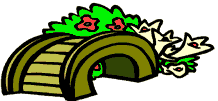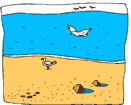The Mystery of is it Mine or Ours?

Did you ride to school on a road today? Yesterday did you skate in a public park? Maybe Mom or Dad traveled home from one of your ball games on their bicycles under a string of street lights? How did the road, the park or the street lights get there? Who paid for them? As a matter of fact, just who owns them? Sounds like a mystery worthy of Sherlock Holmes!
Discuss with your class the following: Did you ride to school on a road today? Yesterday did you skate in a public park? Maybe Mom or Dad traveled home from one of your ball games on their bicycles under a string of street lights? How did the road, the park or the street lights get there? Who paid for them? As a matter of fact, just who owns them? Sounds like a mystery worthy of Sherlock Holmes!
Introduction
It can be a real mystery where some things come from and who is responsible for their upkeep. If you build a bridge to cross the stream, you may have paid for all the materials. Yet once it’s there, everyone seems to take this short cut to school. After awhile you see that the bridge is beginning to have broken boards and is in general need of repairs and a new coat of paint. Hey, what’s the deal here? Why don’t the other students who use this shortcut, pitch in and help keep it in working order?
cross the stream, you may have paid for all the materials. Yet once it’s there, everyone seems to take this short cut to school. After awhile you see that the bridge is beginning to have broken boards and is in general need of repairs and a new coat of paint. Hey, what’s the deal here? Why don’t the other students who use this shortcut, pitch in and help keep it in working order?
Learning Objectives
- Categorize examples of public vs. private goods.
- Brainstorm a list of goods and services and explain whether they are publicly or privately provided.
- Explain why some goods and services are generally not provided by the private sector.
- Explain why governments in market economies play a role in providing important goods and services.
- Explain that goods and services will not be produced by private parties unless producers have sufficient incentive to produce and consumers have sufficient incentive to pay for them.
Resource List
-
Teacher Background Reading: Refresh your own understanding of why some goods are clearly public and others are clearly private.
www.econedlink.org/lessons/docs_lessons/462_Teacher_background1.pdf
-
You Are All Wet: A text to be read aloud and discussed, providing an analytical exercise in which you and the students solve the problem of the crowded beach.
www.econedlink.org/lessons/docs_lessons/462_You_are_all_wet1.pdf
-
Definition Activity : pop up review – Here students are given a list of terms with definitions that pop-up when you roll over them. They will need to determine where to place them in the grid based on their knowledge of the terminology.
-
Interactive Activity: A drag and drop sorting activity to reinforce which activities and individuals are typically considered to be providers of public or private goods — and perhaps ones that could be both.
-
Paradise: A reader's theater text focused on property rights, with discussion questions.
www.econedlink.org/lessons/docs_lessons/462_Paradise_Island1.pdf
-
Quiz: Use this quiz to assess students knowledge of the concepts presented in this lesson.
Quiz
Quiz Answers
Process
If you are unfamiliar with the concepts of public vs. private goods, you may wish to print out the Teacher Background sheet to provide you with a concept briefing. You will want to begin with an introductory discussion about the distinction between private and public goods and services.
 In order to introduce the concepts, use the short reading, ‘You are all wet!‘ Either present this as a topic for class discussion, assign it to students as home work, requesting that they write a position statement on the use of the beach, or divide the class up into small groups and have each group present a solution.
In order to introduce the concepts, use the short reading, ‘You are all wet!‘ Either present this as a topic for class discussion, assign it to students as home work, requesting that they write a position statement on the use of the beach, or divide the class up into small groups and have each group present a solution.
The following answers are only suggested possible responses to the questions in regards to ‘You are all wet!’:
- Why do communities have property rights? [In a market based economy private property rights define who has use of the resource. We often think of private property as only land, however private property also extends to other items of value, such as chickens, cattle, oil, gold, small lakes, boats, etc.]
- What purpose do property rights serve? [It defines a legal owner for an item of value.]
- Are these kinds of rights fair? Why? [This probably depends on which side of the discussion you are on. If you bought a home and paid for the beachfront access, kept it clean, built a nice deck and boardwalk, you would probably believe that being able to exclude others was and is fair. After all, you have spent money and energy to improve and maintain the area. However, if you could not afford this type of property, you might believe that the beachfront should be without restriction.]
- What are some of the advantages of property rights? [In the long run the resource is better cared for – whether it is grazing land, a lake, a farm field, or whatnot. It keeps the resource from becoming fully exhausted by those who use it.]
- What are some of the disadvantages that occur because of private property rights? [Some people may be excluded from the use of a particular resource due to lack of time or money.]
- Where do you think the idea of property rights came from? [This is a lesson that has been known for thousands of years. A good example can be found medieval times when the property (land) and everything on it belonged to the king or to whomever he granted the title.]
- Are property rights the same in every society/country? [No, other economic systems may limit or prohibit many activities such as property ownership, e.g. societies governed by socialist or communistic principles.]
After discussing the preceding questions, would you advise them to go ahead or not? Why or why not? [Answers here will vary with the students, the outcome to this question may even have to be decided by a vote.]
- Using the Definition Activity students can review the pop up definitions of public and private goods; then they can move on to the Interactive Activity.
- As a quick concept review students may use the Interactive Activity to identify public, private or either, goods and services. You may do this by printing out the activity and having the students use different colored highlighters or markers.
- Print out the reader’s theater, Paradise. Select five students to read the parts as the narrators. After the class has heard the play, divide the students into three groups. Have one group, step away from the discussion and plan to serve a the jury to decide this mediation. Of the other two groups, one will portray the Colonists, and one the Aliens. Have each side develop 5-10 statements that would be their argument before a mediation panel. Excuse the panel to deliberate and create a verdict/solution as to what should be done.
Conclusion
It is important to understand the concept of goods and services. There are many differences between goods and services, and goods and services make an impact on the publics daily life.
[Note to teacher: This lesson provides many opportunities for extension activities. You may consider taking this opportunity to discuss public protection, pollution, regulation, or taxation with your students.]
Assessment
Create an extended list of goods and services — some public, some private, and some with characteristics of both categories. Place each listed item on a file card. Have the students help in this activity by creating cards to generate a pool of items you can use — about 50 to 100 examples. Use these as you would a ‘spell down’ where the class is divided into teams (2-3 students per team). Line the teams up along the walls and give each in turn an example. For each example, a team member must say whether it is public, private, or both. An explanation also must be given for each answer. When a student answers incorrectly, he or she sits down. Continue alternating between teams until you have a ‘last person standing.’ That student’s team wins the game. If you prefer to do so, you may also devise a system for awarding points and keeping track of scores. Print out the attached quiz for an alternative assessment. Use the attached to check students answers.

